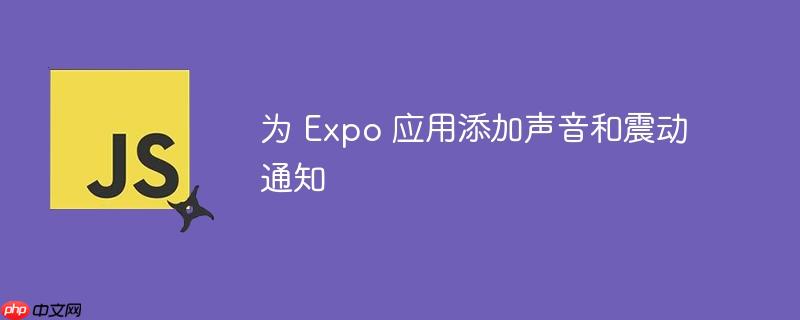
本文档旨在指导开发者如何在 Expo 应用中集成声音和震动通知功能。通过使用 expo-av 和 react-native 提供的 Vibration API,你可以为你的应用添加更丰富的用户体验。本文将详细介绍如何配置通知处理程序、加载和播放声音文件,以及触发设备震动,并提供示例代码和注意事项,帮助你解决常见问题,成功实现声音和震动通知。
首先,确保你的 Expo 项目已经安装了必要的依赖包。 如果没有,请使用以下命令安装:
npx expo install expo-notifications expo-av
此外,react-native 已经内置了 Vibration API,无需额外安装。
要使声音和震动在通知到达时生效,你需要正确配置 Notifications.setNotificationHandler。 这个函数允许你自定义通知的处理方式。
import * as Notifications from 'expo-notifications';
Notifications.setNotificationHandler({
handleNotification: async () => ({
shouldShowAlert: true,
shouldPlaySound: true,
shouldSetBadge: false,
}),
});shouldPlaySound: true 确保通知到达时播放声音。 shouldShowAlert: true 确保显示通知横幅。
使用 expo-av 播放声音文件,需要在应用中加载声音资源并在通知触发时播放。
加载声音文件: 使用 Audio.Sound.createAsync 加载声音文件。
import { Audio } from 'expo-av';
import { useEffect, useState } from 'react';
const [sound, setSound] = useState(null);
useEffect(() => {
async function loadSound() {
try {
const { sound } = await Audio.Sound.createAsync(
require('./assets/notification_sound.mp3') // 替换为你的声音文件路径
);
setSound(sound);
} catch (error) {
console.error('Failed to load sound', error);
}
}
loadSound();
return () => {
if (sound) {
sound.unloadAsync();
}
};
}, []);确保将 notification_sound.mp3 替换为你实际的声音文件路径。
播放声音: 在发送通知时,确保通知内容包含 sound 属性。 如果使用本地通知,则无需额外配置。 如果使用推送通知,请确保推送 payload 中包含 sound 字段。
示例 (本地通知):
import * as Notifications from 'expo-notifications';
async function schedulePushNotification() {
await Notifications.scheduleNotificationAsync({
content: {
title: "Reminder!",
body: 'Time to do something!',
data: { data: 'goes here' },
},
trigger: { seconds: 5 },
});
}确保在发送通知之前,声音文件已经成功加载。
使用 react-native 的 Vibration API 可以触发设备震动。
import { Vibration } from 'react-native';
const vibrate = () => {
Vibration.vibrate(); // 默认震动 500ms
};
// 可以自定义震动模式
const vibrateCustom = () => {
const pattern = [0, 500, 200, 500]; // 停止 0ms, 震动 500ms, 停止 200ms, 震动 500ms
Vibration.vibrate(pattern);
};
const stopVibration = () => {
Vibration.cancel();
};在需要触发震动的地方调用 vibrate() 或 vibrateCustom() 函数。 Vibration.cancel() 可以停止正在进行的震动。
在通知处理程序中触发震动:
import * as Notifications from 'expo-notifications';
import { Vibration } from 'react-native';
Notifications.setNotificationHandler({
handleNotification: async () => {
Vibration.vibrate(); // 在收到通知时震动
return {
shouldShowAlert: true,
shouldPlaySound: true,
shouldSetBadge: false,
};
},
});确保你的应用具有发送通知的权限。 使用 Notifications.getPermissionsAsync() 检查权限状态,并使用 Notifications.requestPermissionsAsync() 请求权限。
import * as Notifications from 'expo-notifications';
import { Alert } from 'react-native';
import { useEffect } from 'react';
useEffect(() => {
async function configurePushNotifications() {
const { status } = await Notifications.getPermissionsAsync();
let finalStatus = status;
if (finalStatus !== 'granted') {
const { status } = await Notifications.requestPermissionsAsync();
finalStatus = status;
}
if (finalStatus !== 'granted') {
Alert.alert(
'Permission required',
'Local notifications need the appropriate permissions.'
);
return;
}
// 权限已授予,可以执行后续操作
}
configurePushNotifications();
}, []);通过本文档,你应该能够成功地为你的 Expo 应用添加声音和震动通知功能。 记住,正确配置通知处理程序、加载和播放声音文件、触发设备震动以及处理权限是实现这一目标的关键。 如果你仍然遇到问题,请仔细检查你的代码和配置,并参考 Expo 和 React Native 的官方文档。
以上就是为 Expo 应用添加声音和震动通知的详细内容,更多请关注php中文网其它相关文章!

每个人都需要一台速度更快、更稳定的 PC。随着时间的推移,垃圾文件、旧注册表数据和不必要的后台进程会占用资源并降低性能。幸运的是,许多工具可以让 Windows 保持平稳运行。

Copyright 2014-2025 //m.sbmmt.com/ All Rights Reserved | php.cn | 湘ICP备2023035733号